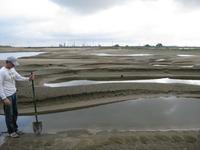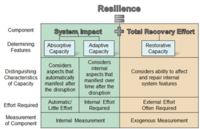-
Dams will not reduce flow of sand to Mississippi River Delta

The wetlands of the Mississippi River Delta are slowly sinking and rapidly eroding, but new research has found the river’s supply of sand — the material engineers most need to rebuild the delta — will stay constant for centuries. The new study is encouraging news for scientists and government officials who are working to shore up southeastern Louisiana’s rapidly disappearing wetlands.
-
-
Helping Kansas counties deal with deficient bridges
Seventy-eight of the 105 counties in the state of Kansas have bridges on low-volume rural roads in dire need of repair, replacement, or removal. With an estimated cost of $150,000 per bridge — and nearly 1,000 bridges across the state in the structurally deficient or functionally obsolete categories — replacement bridges are an expensive proposition. A new study offers a way to determine which bridges should be repaired, and which should be closed.
-
-
Dynamic atolls give hope that Pacific Islands can defy sea rise
It is widely predicted that low-lying coral reef islands will drown as a result of sea-level rise, leaving their populations as environmental refugees. New evidence, however, now suggests that these small islands will be more resilient to sea-level rise than we thought. The new findings suggest that, rather than being passive lumps of rock that will be swamped by rising seas and eroded by storms, the islands are dynamic structures that can move and even grow in response to changing seas. Although the islands may survive into the future, the changes could still affect issues like fresh water and agriculture, potentially making life on these islands much more difficult than it is today.
-
-
More, bigger wildfires burning western U.S.

Wildfires across the western United States have been getting bigger and more frequent over the last thirty years — a trend that could continue as climate change causes temperatures to rise and drought to become more severe in the coming decades, according to new research.
-
-
Long-term predictions for Miami sea level rise could be available soon
Researchers say that Miami could know as early as 2020 how high sea levels will rise into the next century. Scientists conclude that sea level rise is one of the most certain consequences of climate change. The speed and long-term height of that rise, however, are unknown. Some researchers believe that sea level rise is accelerating, some suggest the rate is holding steady, while others say it is decelerating. Scientists say that numbers should continue to be crunched every decade, creating more certainty in long-term planning — and helping develop solutions for a changing planet.
-
-
How building codes save homes from cyclones, and how they don’t
During Queensland’s preparations for Severe Tropical Cyclone Ita, Queensland Premier Campbell Newman advised residents who lived in older houses (those built before 1985) to evacuate their homes as they were not likely to stand up to the storm’s destructive winds. That was the year that building regulations changed to require new houses in cyclone-prone areas to be able to withstand higher winds. But how were these regulations determined, what do they mean for modern homes, and why do regulators always seem to wait until after a severe storm before updating the codes?
-
-
West Point wins Cyber Defense Exercise, launches Army Cyber Institute
The U.S. Military Academy at West Point has won the annual Cyber Defense Exercise (CDX) which brought together senior cadets from the five service academies for a 4-day battle to test their cybersecurity skills against the National Security Agency’s (NSA) top information assurance professionals. West Point’s win comes just as the academy announced plans for its Army Cyber Institute(ACI), intended to develop elite cyber troops for the Pentagon.
-
-
How the Heartbleed bug reveals a flaw in online security
The Heartbleed bug – which infects an extremely widespread piece of software called OpenSSL — has potentially exposed the personal and financial data of millions of people stored online has also exposed a hole in the way some security software is developed and used. The Heartbleed bug represents a massive failure of risk analysis. OpenSSL’s design prioritizes performance over security, which probably no longer makes sense. But the bigger failure in risk analysis lies with the organizations which use OpenSSL and other software like it. A huge array of businesses, including very large IT businesses with the resources to act, did not take any steps in advance to mitigate the losses. They could have chosen to fund a replacement using more secure technologies, and they could have chosen to fund better auditing and testing of OpenSSL so that bugs such as this are caught before deployment. They didn’t do either, so they — and now we — wear the consequences, which likely far exceed the costs of mitigation.
-
-
California implements earthquakes’ lessons
In California, government engineers study structures that did not survive the earthquake, with plans to make improvements to building codes. The most important code changes tend to occur because earthquakes uncover weaknesses in contemporary construction standards.”Every time the earth shakes there’s something a little different about it,” says one official.
-
-
Feds struggle to plug power grid security holes
Many of the current vulnerabilities in the power grid are attributable to newly adopted smart-grid technology, which allows operators to transmit energy from a diverse pool of resources. Smart-grid technology relies on devices in remote locations which constantly communicate with substations, those access points can be compromised by hackers.
-
-
A grid of the right size could reduce blackout risk
Scientists argue that for every animal there is an optimal size — one which allows it to make best use of its environment and the physical laws that govern its activities, whether hiding, hunting, hoofing, or hibernating. Now, researchers are asking whether there is a “right” size for another type of huge beast: the U.S. power grid. The researchers believe that smaller grids would reduce the likelihood of severe outages, such as the 2003 Northeast blackout that cut power to fifty million people in the United States and Canada for up to two days.
-
-
Bangladesh tops list of countries at risk from sea level rise
Scientists say that see levels may rise by up to the feet by 2100.The implications of this would have drastic consequences for nearly all coastal nations, but the consensus is that Bangladesh will be the hardest hit by the change. Leading Bangladeshis say that since Bangladesh produces less than 0.3 percent of the emissions driving climate change, it would unjust for Bangladesh to rely on its own meager resources to solve this problem. One solution they offer: fifty million Bangladeshis (out of a population of 163 million) should be allowed to move to and resettle in the countries which produce the bulk of greenhouse gasses.
-
-
Coalition sounds alarm about possible global EMP disaster
A coalition that includes former speaker of the House Newt Gingrich and former CIA director James Woolsey has issued a terse warning regarding apocalyptic effects that could result from a mass EMP (electromagnetic pulse) disaster or attack. Members of the coalition “are convinced that our fragile electrical grid could be wiped out at any moment” from bursts of electrical energy caused by anything from a nuclear explosion to a solar flare from the sun, leading to chaos on a global scale.
-
-
Capabilities-based – rather than actuarial -- risk analysis would make businesses safer
Many businesses and organizations, when applying cost-benefit analysis and a risk-management analysis to measure cyber risk, are relying on the assumption that the likelihood of a future attack depends heavily on how many attacks have occurred in the past. Since there has yet to be a full-scale attack on critical infrastructure in the United States, it is simple to conclude that the risk of a cyberattack on critical infrastructure is low, therefore justifying low investment in additional security initiatives. An actuarial risk analysis may conclude that there is little likelihood of such as attack occurring, but a capabilities-based risk analysis recognizes that since adversaries are capable of such an attack, it is in an organization’s best interest to secure against it.
-
-
Sandia to help cities be better prepared for, emerge stronger from, disasters

Sandia National Laboratories says it will bring its experience solving problems with practical engineering and modeling complex systems to cities around the world under a new agreement to support the 100 Resilient Cities Centennial Challenge, pioneered by the Rockefeller Foundation. The challenge, which will help thirty-three cities in its first year, seeks to make communities more resilient by being better prepared to withstand natural or manmade disasters, recover more quickly, and emerge stronger.
-
More headlines
The long view
Helping Strengthen America’s Critical Infrastructure
Everyday life depends on a robust infrastructure network that provides access to running water, communications technology and electricity, among other basic necessities. The experts who keep our national infrastructure secure and resilient also need a strong network to share their knowledge and train the next generation of professionals capable of solving complex infrastructure challenges.
AI and the Future of the U.S. Electric Grid
Despite its age, the U.S. electric grid remains one of the great workhorses of modern life. Whether it can maintain that performance over the next few years may determine how well the U.S. competes in an AI-driven world.
